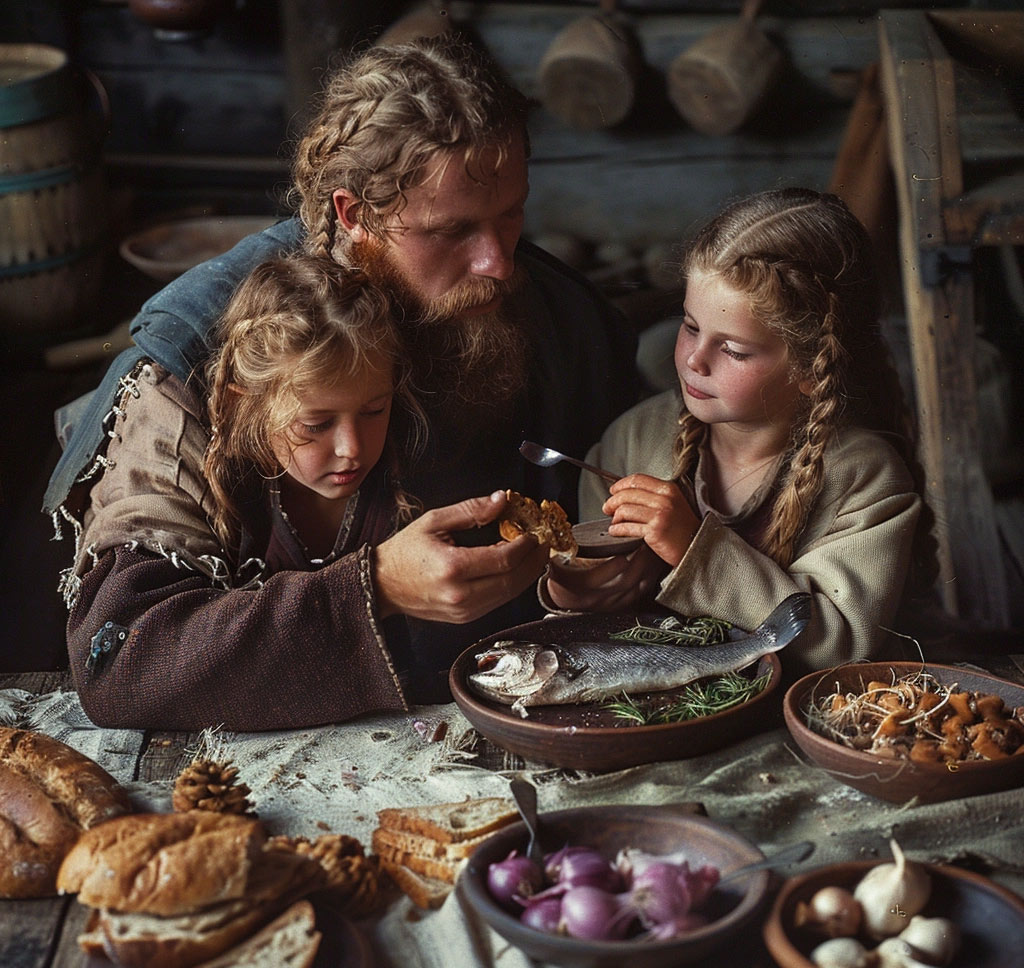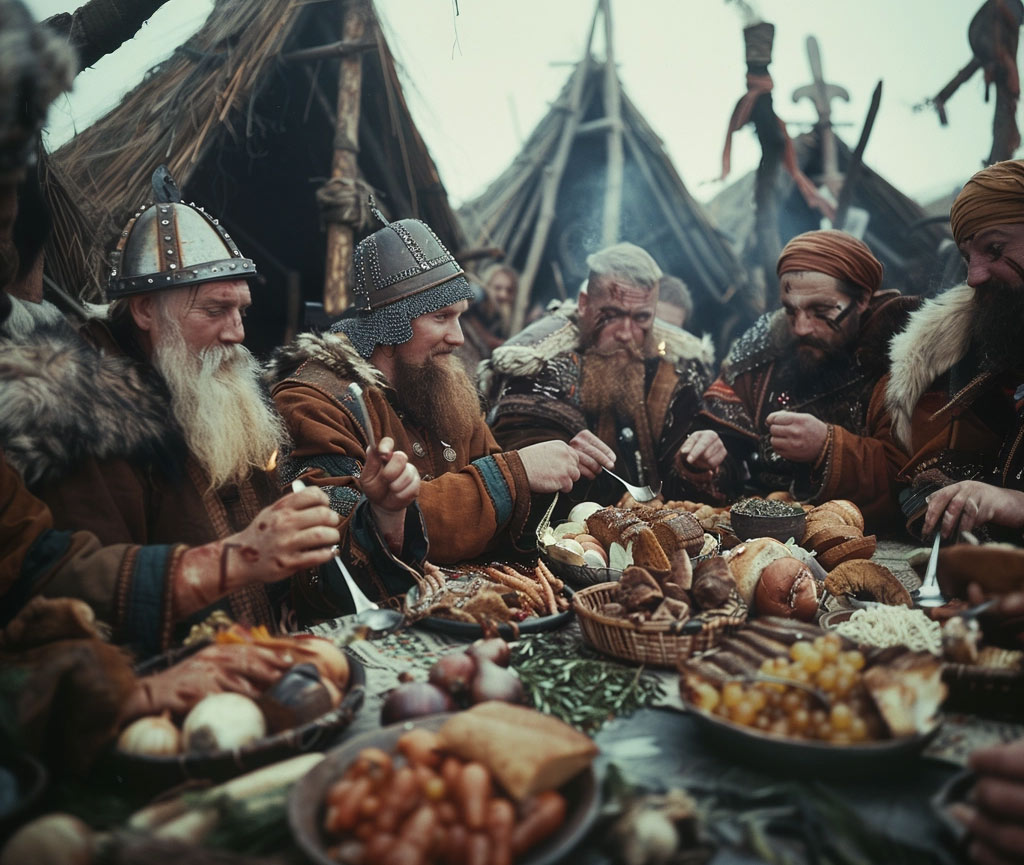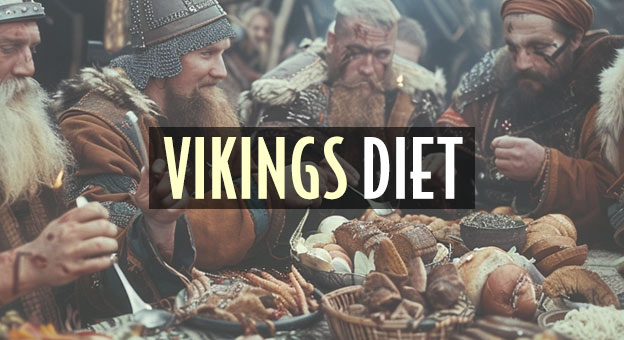The Vikings were seafaring warriors and traders from Scandinavia during the late 8th to early 11th centuries. Even though they lived in a cold, harsh climate with long Winters, they had a surprisingly diverse and nutritious diet and had an active lifestyle.
So, was the Viking’s diet healthy? Let’s take a culinary voyage back in time and see what was on the Vikings’ menu to learn what they ate and drank plus how their sea-faring and plundering lifestyle kept them in shape.
Viking diet: Food | Drink | Healthy? | Fitness | Strength competitions
Viking Diet & Food List

First off, the Vikings were practical eaters. Their diet was heavily influenced by the harsh seasonal climate of Scandinavia and the need for sustenance during long voyages. They relied on both agriculture and fishing as primary food sources. Here are foods that were staples of the Viking diet:
- Grains: Barley and rye were the go-to grains, used to make bread and porridge. These grains were hardy enough to withstand the cool climates of Scandinavia. Oats were also utilized but to a lesser extent.
- Vegetables: Vikings cultivated onions, beans, peas, and cabbages. Wild vegetables such as nettles, mushrooms, and garlic were also gathered. These would have added valuable nutrients and variety to their diet.
- Fruits and Nuts: Though not as prevalent in their diet, Vikings did consume apples, berries (such as lingonberries and cloudberries), and nuts when available. These would have been important sources of vitamins and minerals.
- Meat and Fish: Meat from domestic animals (cattle, sheep, goats, pigs, and poultry) was part of the Viking diet but was more common for the well-off. More universally consumed were fish and seafood, given Scandinavia’s extensive coastlines. Herring, salmon, and cod were staples, often dried or salted for preservation.
- Dairy: The Vikings kept cows, goats, and sheep, not just for meat but for milk, which they turned into butter, cheese, and skyr (a type of yogurt). Dairy products would have been a crucial protein and fat source.
- Eggs: Eggs from chickens and wild birds were also consumed whenever available.
Quick thought: There seems to be a theme that our ancient ancestors were a lot healthier than us, even though WW wouldn’t be founded for another thousand years!
Various beverages were also important to the diet of Vikings, so let’s look at what they drank.
What Did the Vikings Drink?
The Vikings weren’t just about mead, though that honey-based alcohol was a favorite at their feasts. They also drank ale, a staple beverage brewed from barley, which was more common for everyday consumption.
Water and milk directly from cows, goats, or sheep were the go-to non-alcoholic options, although they lived centuries before pasteurization, so the milk had to be fresh.
For a special kick, they might have enjoyed imported wine, but that was a luxury mostly savored by the wealthy. So, whether toasting to Odin or just quenching their thirst, the Vikings had a myriad of drink options for various occasions.
Was the Vikings’ Diet Healthy?

So, was the Viking diet healthy? By many accounts, yes. The variety in the Viking diet, with its emphasis on grains, fish, and vegetables, provided a balanced intake of carbohydrates, proteins, and fats. Their consumption of fermented foods like skyr and preserved fish also introduced beneficial probiotics into their diet, aiding in digestion and overall health.
Fish, a staple in their diet, is rich in omega-3 fatty acids, which are known for their heart health benefits and could have contributed to the Vikings’ strength and endurance. The reliance on whole grains and vegetables would have provided essential vitamins and fiber, promoting digestive health and potentially preventing many chronic diseases common in modern diets.
However, it’s worth noting that the Vikings’ access to fresh fruits and vegetables would have been seasonally restricted, possibly leading to vitamin deficiencies during the winter months. The heavy reliance on salted and smoked fish for preservation could also have increased their salt intake, potentially raising the risk for hypertension, though the physical demands of their lifestyle might have mitigated some of these effects.
Vikings Fitness & Exercise:
The Vikings were in excellent physical shape, a necessity given their lifestyle. Think of them as the ultimate multitaskers: farmers, sailors, explorers, and warriors. Their daily life was a rigorous physical workout. Farming alone, without the modern machinery we have today, required significant muscle power and endurance. Then, consider the rowing. Long voyages on their iconic longships demanded exceptional upper body strength and stamina.
Moreover, the Viking diet, rich in proteins, healthy fats, and whole grains, supported lean muscle development while avoiding obesity and diabetes. Their food was natural, unprocessed, and free of the excessive sugars and fats that plague our modern diets.
Vikings were certainly more active than modern Americans. The sedentary lifestyle that’s become common today was simply not an option for Vikings. Also, we’re talking about a period 1000 years before the Grand Theft Auto and The Real Housewives, so the Vikings spent a lot of time being active outdoors.
The Vikings’ survival depended on being fit, agile, and ready for anything, whether tilling the soil or setting sail into the unknown. Their physically demanding lifestyle, combined with a natural diet, likely made obesity rare and kept them in far better shape than the average American today.
couponswellness01
Viking Strength Competitions, Workouts:
The Vikings had various forms of strength competitions and physical contests that were an important part of their culture. These competitions were not only a way to demonstrate physical prowess but also served social, military, and ceremonial purposes. Here are some examples of the types of strength competitions and physical contests the Vikings engaged in:
- Wrestling (Glíma): Wrestling was highly respected and widely practiced among the Vikings. Glíma, a traditional form of wrestling, was considered the sport of the Vikings. It involved techniques that required strength, agility, and strategy. The objective was to make the opponent touch the ground with a part of the body other than the feet.
- Stone Lifting: Lifting heavy stones was another common test of strength among the Vikings. They would lift large stones to certain heights or carry them over distances. These feats were often used to prove one’s worthiness for various tasks or roles within Viking society.
- Holmgang: Though more of a duel than a competition, holmgang was a way to settle disputes and involved combat between two individuals. It required both strength and combat skills, and the outcome was often seen as a testament to one’s physical prowess.
- Log Carrying and Boat Pulling: Vikings also engaged in challenges that involved carrying heavy logs or pulling boats over land. These tasks simulated real-life activities that were crucial for their survival and success in raids.
- Horse Fighting: While not a direct test of human strength, organizing and participating in horse fights was a popular activity among the Vikings. It showcased the owner’s status and the strength and training of their horses.
These activities were more than mere sports; they were integral to the Viking way of life, reflecting their values of strength, honor, and prowess in battle. They also served as training for young warriors, helping them develop the skills necessary for raiding and warfare.
Vikings Diet Plan Fad?
In conclusion, the Vikings’ diet was remarkably balanced and nutritious, considering the period and their environment. Their diet is a fascinating reflection of how the Vikings adapted to their surroundings, making the most of the resources available to them. While they might not have known the nutritional science we do today, the diet of Vikings supported a lifestyle that required robust health and endurance, allowing them to explore, raid, and trade across vast distances. So, in a way, their diet was not just about survival but about thriving in a world that was as challenging as it was expansive.
Considering the interest in the diets of groups like cavemen (aka Paleo) I wouldn’t doubt if you see a “Vikings diet” fad one day.
What would a Viking diet and workout be like? The Viking diet would probably consist of eating fresh fish, grains, berries, and lots of time on the rowing machine and stair-stepper at the gym!
Hmmm… Even though I’m mostly kidding, a Viking diet probably wouldn’t be bad to follow. Just don’t get carried away and start plundering your neighbors.
Thanks for stopping by Wonky Pie!

